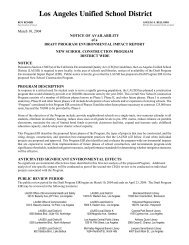Site-Specific Health and Safety Plan (HASP) - Laschools.org
Site-Specific Health and Safety Plan (HASP) - Laschools.org
Site-Specific Health and Safety Plan (HASP) - Laschools.org
Create successful ePaper yourself
Turn your PDF publications into a flip-book with our unique Google optimized e-Paper software.
precision range from zero to the historical mean plus three st<strong>and</strong>ard deviations. An RPD<br />
within the control limit indicates satisfactory precision in a measurement system.<br />
2.2.2 Accuracy<br />
Accuracy is a measure of the closeness of a reported concentration to the true value.<br />
Accuracy is expressed as a bias (high or low) <strong>and</strong> is determined by calculating percent<br />
recovery (%R) from MS/MSDs, LCSs, <strong>and</strong> surrogate spikes. MS/MSD <strong>and</strong> surrogate<br />
spike recoveries indicate accuracy relevant to a unique sample matrix. LCS recoveries<br />
indicate accuracy relevant to an analytical batch lot, <strong>and</strong> are strictly a measure of<br />
accuracy conditions in preparation <strong>and</strong> analysis independent of samples <strong>and</strong> matrices.<br />
The %R of an analyte, <strong>and</strong> the resulting degree of accuracy expected for the analysis of<br />
spiked samples for QC, are dependent upon the sample matrix, method of analysis, <strong>and</strong><br />
the compound or element being measured. The concentration of the analyte relative to<br />
the detection limit of the method is also a major factor in determining the accuracy of the<br />
measurement.<br />
Accuracy expressed as %R is calculated as follows:<br />
where:<br />
%R = [(A-B)/C] x 100<br />
A = measured concentration in spiked sample,<br />
B = measured sample concentration (without spike), <strong>and</strong><br />
C = concentration of spike added.<br />
The laboratory shall have procedures in place for establishing <strong>and</strong> updating accuracy<br />
control limits. Typical control limits for accuracy are based on the historical mean plus<br />
or minus three st<strong>and</strong>ard deviations.<br />
2.2.3 Completeness<br />
Completeness is defined as the percentage of laboratory measurements judged to be valid<br />
on a method-by-method basis. Valid data are defined as all data <strong>and</strong>/or qualified data<br />
considered to meet the DQOs for this project. Data completeness is expressed as percent<br />
complete (PC) <strong>and</strong> should be ≥ 90 percent. The goal for meeting analytical holding times<br />
is 100 percent. At the end of each sampling event, the completeness of the data will be<br />
assessed. If any data omissions are apparent, new samples will be collected <strong>and</strong><br />
reanalyzed for the parameter in question, if feasible. Laboratory results will be<br />
monitored as they become available to assess laboratory performance <strong>and</strong> its effect on<br />
data completeness requirements. When appropriate, additional samples will be collected<br />
to ensure that laboratory performance meets PC requirements.<br />
2-3<br />
K:\Depts\Dept48\LAUSD\MSA WORK\QAPP\Draft Final QAPP to DTSC\QAPP for OU 1 RAP.DOC<br />
288







